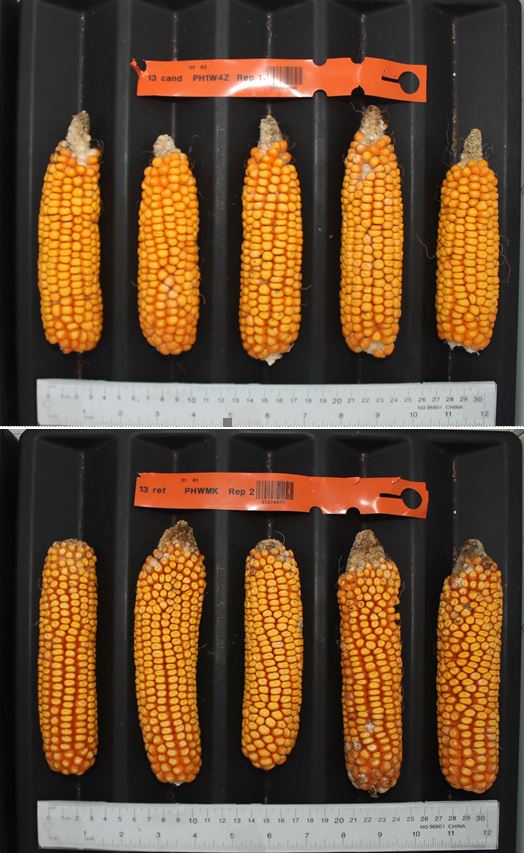PH1W4Z
| Denomination: | 'PH1W4Z' |
|---|---|
| Botanical Name: | Zea mays |
| Applicant/Holder: |
Pioneer Hi-Bred International, Inc. 7100 NW, 62nd Avenue P.O. Box 1000 Johnston, Iowa 50131-1000 United States of America |
| Breeder: |
Gary Weber, Pioneer Hi-Bred International, Inc., Sioux Falls, United States of America |
| Agent in Canada: |
Pioneer Hi-Bred Production Co. 240, 115 Quarry Park Road SE Calgary, Alberta T2C 5G9 Canada Tel: 403-440-2988 |
| Application Date: | 2019-04-23 |
| Provisional Protection:: | 2019-04-23 |
| Application Number: | 19-9794 |
| Grant of Rights Date: | 2022-05-17 |
| Certificate Number: | 6592 |
| Grant of Rights Termination Date: | 2042-05-17 |
Variety Description
Variety used for comparison: 'PHWMK'
Summary: The angle between the main axis and lateral branches on the tassel of 'PH1W4Z' is very small to small while it is small to medium for 'PHWMK'. The second lateral branch from the bottom of the tassel of 'PH1W4Z' is straight, while it is slightly recurved for 'PHWMK'. Midway through anthesis, the silks of 'PH1W4Z' have a weak intensity of anthocyanin colouration while those of 'PHWMK' have a medium to strong intensity of anthocyanin colouration. From the beginning of anthesis to just before milk development, the brace roots of 'PH1W4Z' have a medium to strong intensity of anthocyanin colouration while those of 'PHWMK' have a very strong intensity of anthocyanin colouration. The main axis of the tassel above the highest lateral branch is very short for 'PH1W4Z' while it is medium in length for 'PHWMK'. Including the tassel, the plants of 'PH1W4Z' are taller than the plants of 'PHWMK'. The leaf blade just above the upper ear of 'PH1W4Z' is narrower than that of 'PHWMK'. Including the kernels, the ears of 'PH1W4Z' have a larger diameter than those of 'PHWMK'. The primary ear of 'PH1W4Z' is located higher on the stem than that of 'PHWMK'.
Description:
PLANT: inbred yellow variety, small to medium ratio for height of insertion of peduncle of upper ear to plant height, anthesis and silk emergence occur mid-season to late in the season
STEM: absent or very slight degree of zig-zag, medium to strong intensity of anthocyanin colouration on brace roots
LEAF BLADE (JUST ABOVE UPPER EAR): strong degree of undulation of margin, small angle with stem, straight to slightly recurved
TASSEL: medium number of primary lateral branches, medium density of spikelets on middle third of main branch, main axis above lowest lateral branch very short, main axis above highest lateral branch very short
LATERAL BRANCHES (SECOND BRANCH FROM BOTTOM OF TASSEL): straight, very small to small angle with main axis, short
GLUME: absent or very weak intensity of anthocyanin colouration throughout
ANTHER (ON MIDDLE THIRD OF MAIN BRANCH): medium intensity of anthocyanin colouration
EAR: weak intensity of anthocyanin colouration of silks, short husk (level with tip), conico-cylindrical shape, few to medium number of rows of grain, absent or very weak intensity of anthocyanin colouration on glumes of cob
EAR WINGS: present on a very low percentage of plants
KERNEL: intermediate between flint-like and dent-like type, yellow on top and dorsal side
TILLERING: present on a low to medium percentage of plants
Origin & Breeding History: 'PH1W4Z' was developed by Pioneer Hi-Bred International, Inc., using a double haploid plant breeding method. In 2005, the initial cross was conducted between proprietary inbred lines in Eau Claire, Wisconsin, USA. The F1 seed was planted, induced to produce haploid seed and the haploid seed bulked in Santiago, Chile. In 2006, the H1 seed was planted in Kekaha, Kauai, Hawaii, USA and induced to create a double haploid. In 2007, the D1 seed was planted, self pollinated with subsequent ear selection in Willmar, Minnesota, USA. In 2009, the D2 seed was planted ear to row, self pollinated and the D3 seed bulked. In 2009 and 2010, the D3 to D5 lines were planted ear to row and self-pollinated with subsequent ear selection. In 2011, the D6 seed was planted, self pollinated and the D7 seed bulked as breeder seed in Brookings, South Dakota, USA. 'PH1W4Z' was selected based on yield in hybrid combination, tassel size, pollen production, germination ability, stalk lodging resistance, late season plant health, grain quality, as well as disease and insect resistance.
Tests & Trials: The comparative trial for 'PH1W4Z' was conducted in Coteau-du-lac, Quebec during the 2019 growing season. The trial was planted in a RCB Design with 3 replicates. Each replicate consisted of one row of approximately 20 plants, 3 metres in length with 76 cm between the rows. There was a total of 50 to 60 plants per variety. Measured characteristics were based on 30 measurements per variety. Mean differences were significant at the 5% probability level based on paired Student's T-tests. Results were supported by the official technical examination report 201400048, purchased from the Plant Variety Protection Office in Washington, District of Columbia, USA.
Comparison tables for 'PH1W4Z' with reference variety 'PHWMK'
Plant height (including tassel) (metres)
| 'PH1W4Z' | 'PHWMK' | |
|---|---|---|
| mean | 1.93 | 1.78 |
| std. deviation | 0.05 | 0.12 |
Leaf blade width (leaf just above upper ear) (cm)
| 'PH1W4Z' | 'PHWMK' | |
|---|---|---|
| mean | 8.26 | 8.98 |
| std. deviation | 0.30 | 0.49 |
Ear diameter (in middle including kernels) (cm)
| 'PH1W4Z' | 'PHWMK' | |
|---|---|---|
| mean | 4.30 | 4.12 |
| std. deviation | 0.13 | 0.24 |
Primary ear, height from ground (metres)
| 'PH1W4Z' | 'PHWMK' | |
|---|---|---|
| mean | 0.89 | 0.74 |
| std. deviation | 0.07 | 0.08 |
Click on image for larger view

Corn: 'PH1W4Z' (top) with reference variety 'PHWMK' (bottom)
- Date modified: